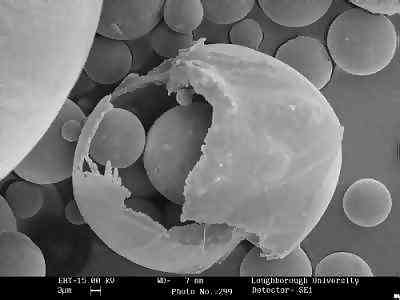Laser
Generated Fume Particulate and Fume Analysis For Health and Safety
Fumes
produced from metal cutting applications using CO2 lasers can be a
potential health hazard. The laser radiation combined with the assist
gas (O2) causes atomisation of the process metal producing a fume
containing small particles of the metal.The particulate forms through
atomisation of melt by the assist gas jet, recondensation and droplets
from the molten pool. Recent work carried out at the Department of
Mechanical Engineering, Loughborough University has looked at the
effects of changing the cutting conditions for different types of mild
steel both on the health of the cutting process itself and the human
health and safety implications of the fumes produced. Factors that have
been monitored include the fume particles' shape and size distributions,
and the laser process operating conditions including the laser
stability, power and focus, assist gas flow and weld temperature as well
as the cut quality.
Non-invasive
monitoring of the CO2 laser stability is provided using the beam monitor
BM10.6, a novel laser beam sampling system from Precision-Optical
Engineering. The BM10.6, is based on the use of single point diamond
turning to produce a very weak diffraction grating on an OFHC copper
substrate (usually a fold mirror). The BM10.6 replaces the final bending
mirror in the optical train. The proportion of the beam sampled, and
even the angle of the outcoupled sample can be varied to allow for
customising to particular optical systems. Typical sampling is of the
order of 0.0005 of the input beam. The use of this sampling system
does not affect the primary function of the beam and can be used
continuously. Laser power is monitored from a current signal readout on
two pyrometers that have previously been calibrated against a power
meter, and a small laser diode is used to check focus.
Both
the forward and backscattered CO2 radiation can be monitored. The
fraction of the main laser beam (forward scattered) provides an
indication of the health of the optical system. The laser power at the
lens (just after the BM10.6) can be compared with the value measured at
the internal shutter dump (calorimeter type). The fraction sampled from
the reflection off the surface of the material to be processed indicates
process stability. Variation in the back-scattered power relate to
fluctuations in the melt zone. It is also very useful for monitoring the
drilling process (especially blind hole drilling). The backscattered
power drops sharply as the beam breaks through the material.
Particulate
size distributions are measured using laser diffraction instrumentation.
The distribution changes with processing parameters and cut quality of
the product. This enables the process ´health═ to be monitored. Much
of the particulate has been shown to have a mean particle size below 30
Ám - and these are respirable. The smallest particulates are formed
when the process is optimised.
Scanning
electron microscopy (SEM) of the particulate provides an indication of
the shape, size and surface structure. SEM images show that the
particulate formed during steel cutting is almost spherical. Some of the
particles formed are hollow - as has been seen in atomised metal powders
for thermal spray applications. From a health and safety point of view ,
the smallest particles are formed when the process is optimised, giving
the highest health hazard.

Figure: SEM image of particulate formed during steel cutting, showing
spherical shapes.
Authors:
Robin Addison, Precision-Optical Engineering, 42 Wilbury Way, Hitchin,
Herts, UK, SG4 0TP, UK
and Dr. John Tyrer, Dr. Karen Williams and Leon Lobo, Department of
Mechanical Engineering, Loughborough University, Loughborough,
Leicestershire, LE11 3TU, UK
Press
Enquiries: Denis Bulgin, In Press PR Ltd. PO Box 24, Royston, Herts, SG8
6TT.
Tel: 01763 262621 Fax: 01763 262655
E-mail: denis@inpress.co.uk http://www.inpress.co.uk
|

